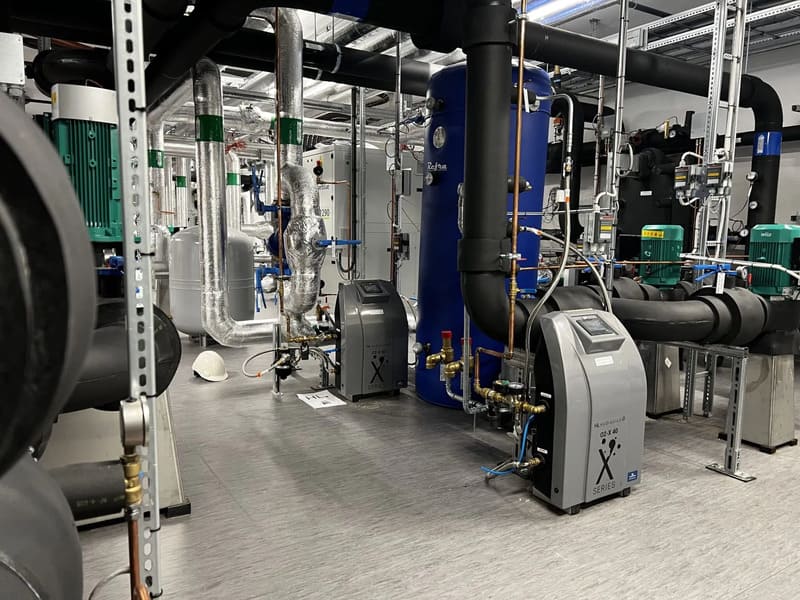
In the world of building services, ensuring that heating and chilled water systems operate at peak efficiency is crucial for both cost-effectiveness and environmental sustainability. One of the most significant yet underappreciated contributors to poor performance in closed-loop systems is the presence of dissolved gases. Oxygen and other gases trapped in the system can lead to corrosion, noise, air locks, and reduced heat transfer efficiency. To tackle these issues effectively, many professionals turn to a vacuum degasser.
A vacuum degasser works by removing dissolved and entrained gases from closed heating and chilled water circuits. Unlike traditional air vents, which only expel large pockets of air, a vacuum degasser can extract even the tiniest gas bubbles and dissolved gases that are otherwise impossible to remove through conventional methods. This advanced degassing technology significantly improves system performance and longevity.
How Does a Vacuum Degasser Work?
A vacuum degasser operates by creating a low-pressure environment inside a degassing chamber. As system water passes through the chamber, the pressure drop causes dissolved gases to come out of solution. These gases then rise to the top of the chamber and are automatically vented to the atmosphere. The degassed water is then reintroduced into the system, now free of the gases that could cause corrosion and circulation problems.
This continuous process ensures that the entire system remains free of air, maintaining optimal heat transfer and preventing common problems like cavitation in pumps, noise in radiators, and corrosion of metallic components.
The Benefits of Vacuum Degassing
The advantages of installing a vacuum degasser go far beyond simple air removal. Key benefits include:
- Reduced Corrosion: By eliminating oxygen, one of the main culprits behind corrosion, a vacuum degasser can dramatically extend the lifespan of boilers, chillers, heat exchangers, and pipework.
- Improved Efficiency: Air and gas bubbles can act as insulators, reducing the heat transfer efficiency of the system. Removing these gases improves energy efficiency, lowers fuel consumption, and supports sustainability goals.
- Quieter Operation: Air trapped in the system can cause noise, such as banging pipes or gurgling radiators. Vacuum degassing eliminates these disturbances, leading to smoother, quieter performance.
- Lower Maintenance Costs: Corrosion and air locks can cause unexpected breakdowns and expensive repairs. A vacuum degasser reduces the likelihood of these issues, resulting in fewer callouts and lower maintenance bills.
- Faster Commissioning: For new systems or after major maintenance work, a vacuum degasser speeds up the commissioning process by rapidly removing air from the circuit.
Applications of Vacuum Degassers
Vacuum degassers are suitable for a wide range of applications, including commercial office buildings, hospitals, schools, industrial facilities, and district heating schemes. Anywhere that closed heating or cooling circuits are used, a vacuum degasser can offer significant benefits.
They are particularly valuable in modern energy-efficient systems, where low flow temperatures and reduced system volumes can make traditional air removal techniques ineffective.
Choosing a Reliable Vacuum Degasser
When selecting a vacuum degasser, it is important to choose a solution that is robust, easy to install, and simple to maintain. Modern vacuum degassers often include user-friendly controls, automatic operation, and durable materials to withstand the demands of commercial and industrial applications.
For a reliable and effective solution, explore the range of vacuum degasser systems offered by Stourflex. Their products are designed to deliver long-lasting performance, reduce operating costs, and protect your heating and cooling infrastructure.
Conclusion
A vacuum degasser is a smart investment for anyone looking to optimise the performance of their heating or chilled water system. By removing dissolved gases, it protects against corrosion, improves energy efficiency, and ensures trouble-free operation. Incorporating a vacuum degasser into your system design or maintenance plan is a proactive step towards a more reliable, sustainable, and cost-effective building services solution.
